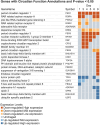Serum-deprivation response of ARPE-19 cells; expression patterns relevant to age-related macular degeneration
- PMID: 39325754
- PMCID: PMC11426544
- DOI: 10.1371/journal.pone.0293383
Serum-deprivation response of ARPE-19 cells; expression patterns relevant to age-related macular degeneration
Abstract
ARPE-19 cells are derived from adult human retinal pigment epithelium (RPE). The response of these cells to the stress of serum deprivation mimics some important processes relevant to age-related macular degeneration (AMD). Here we extend the characterization of this response using RNASeq and EGSEA gene set analysis of ARPE-19 cells over nine days of serum deprivation. This experiment confirmed the up-regulation of cholesterol and lipid-associated pathways that increase cholesterol levels in these cells. The gene expression analysis also identified other pathways relevant to AMD progression. There were significant changes in extracellular matrix gene expression, notably a switch from expression of collagen IV, a key component of Bruch's membrane (part of the blood-retina barrier), to expression of a fibrosis-like collagen type I matrix. Changes in the expression profile of the extracellular matrix led to the discovery that amelotin is induced in AMD and is associated with the development of the calcium deposits seen in late-stage geographic atrophy. The transcriptional profiles of other pathways, including inflammation, complement, and coagulation, were also modified, consistent with immune response patterns seen in AMD. As previously noted, the cells resist apoptosis and autophagy but instead initiate a gene expression pattern characteristic of senescence, consistent with the maintenance of barrier function even as other aspects of RPE function are compromised. Other differentially regulated genes were identified that open new avenues for investigation. Our results suggest that ARPE-19 cells maintain significant stress responses characteristic of native RPE that are informative for AMD. As such, they provide a convenient system for discovery and for testing potential therapeutic interventions.
Copyright: This is an open access article, free of all copyright, and may be freely reproduced, distributed, transmitted, modified, built upon, or otherwise used by anyone for any lawful purpose. The work is made available under the Creative Commons CC0 public domain dedication.
Conflict of interest statement
The authors have declared that no competing interests exist.
Figures







References
-
- Curcio CA, Johnson M. Structure, Function, and Pathology of Bruch’s Membrane. In: Stephen J. Ryan SRS,… Andrew P. Schachat, editor. Retina (Fifth Edition). 1: Elsevier; 2013. p. 465–81.
-
- Fritsche LG, Fariss RN, Stambolian D, Abecasis GR, Curcio CA, Swaroop A. Age-Related Macular Degeneration: Genetics and Biology Coming Together. In: Chakravarti A, Green E, editors. Annual Review of Genomics and Human Genetics, Vol 15. Annual Review of Genomics and Human Genetics. 15. Palo Alto: Annual Reviews; 2014. p. 151–71. - PMC - PubMed
MeSH terms
Substances
LinkOut - more resources
Full Text Sources
Medical
Molecular Biology Databases
Research Materials

